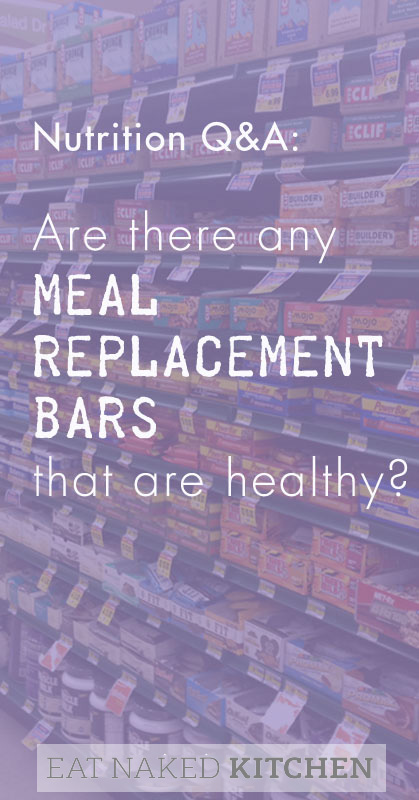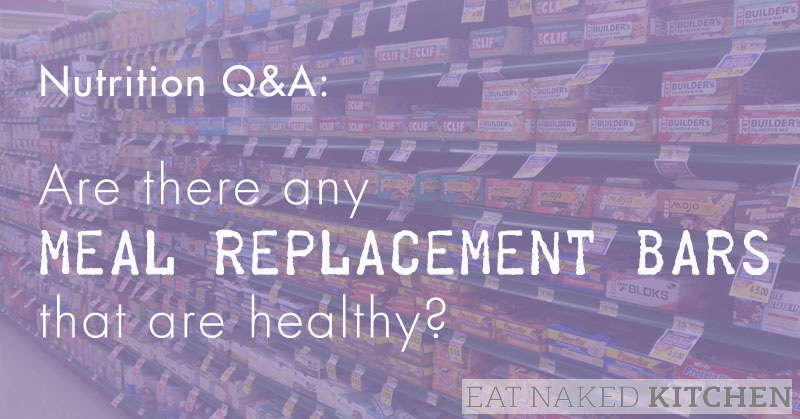This week’s question comes from Caroline, who asks: Are there any meal replacement bars that are healthy.
Here’s a Margaret insider tip: If you want to see me have a meltdown, put me in the meal replacement / health/ energy bar section of any given store and ask me to pick one. I’ll start out bound and determined to find you a good option. Quickly I’ll get overwhelmed and distraught. You might notice me shake and twitch as beads of sweat form on my forehead. And the whole thing will end in tears.
You think I exaggerate.
There is no part of the “health food” industry that causes me more angst than the meal replacement bar makers. The unfortunate truth is that there is no good option. Either you’re getting promises of high protein/low carb (read: soy, soy, and more soy), “all natural” (don’t get me started), or high-fibre low-fat (read: sugar, sugar, and more sugar). There are a few 100% real food bars on the market (Lara bars are a good example), and I commend the manufacturer for giving it a good try, but they are so high in sugar I simply can’t recommend them in good conscience.
You see the trouble with energy bars is that by design they are problematic. They need to taste good, and at the same time offer whatever nutritional promise the marketers want to deliver.
The optimal energy bar would be high in complete and unadulterated quality proteins, have some good real fat for lasting energy, and be low in sugars and starch. It would be made from 100% real food. It would be tasty.
I know of no such bar. (But I am willing to be proved wrong…)
My personal favorite real-food power-packed and ultra-easy on-the-go snacks include:
- a hard boiled egg (even comes with its own packaging)
- a couple of slices of cheese (ideally organic and raw) and a piece of fruit
- a handful of raw (even better: soaked and dehydrated) nuts and berries
- a can of sardines (before you crinkle your nose, they’re an awesome and portable quick hit of protein and important essential fatty acids)
- a half avocado with a squeeze of lemon
You’ll notice that all of these snacks are low in starch and sugars and have some good fat and/or protein to keep you satiated for a while, rather than just create a sugar spike/crash situation.

If you absolutely must resort to an energy bar, here are the things to watch out for:
- Soy in any form. It’s ubiquitous and far from the health food it is claimed to be. If this is news to you, read this and this.
- Anything hydrolyzed. Hydrolyzation is an extremely intense form of protein isolation that creates toxic by products you get to eat. Neurotoxin, anyone? Yum.
- High fructose corn syrup and other commercial sweeteners, including artificial non-caloric sweeteners. And agave (almost as ubiquitous as soy in “health” foods and just as disastrous for you). Here’s a list of the natural sweeteners we recommend.
- Any ingredient you don’t recognize and couldn’t buy at a grocery store to make yourself.
Does this sound like a tall order? It is, and it’s incredibly hard to find.
If you know of a 100% real food meal replacement bar that meets the criteria I outlined above for the optimal energy bar, please let me know! I’d love to know of one I can happily recommend.




I’d rather have a real chocolate. And if its mostly dark, its so much healthier than those energy bars. Another myth along these lines is that fruit juice is somehow healthier than soda cooldrinks. The diet of the general human walking in the modern city basically is almost equivalent to eating spoons and spoons of sugar straight from the sugar bowl. Scary.
Check out the RxBar (http://rxbar.com/) – egg protein + fruit. Some might find the dried fruit a little high carb, but it’s definitely all real food!
Great article! Thanks for sharing, I re-posted on my Facebook to share with all my fitness fanatics ; )
The boku superfood bar is pretty great! High protein high fat low ish carbs and tastes good but not too sweet.